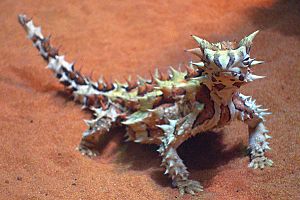Alice Springs Desert Park facts for kids

Alice Springs Desert Park logo
|
|
| Date opened | March 1997 |
|---|---|
| Location | Alice Springs, Northern Territory, Australia |
| Land area | 1,300 hectares (3,212 acres) |
| Coordinates | 23°42′23″S 133°49′57″E / 23.7065°S 133.8325°E |
| No. of species | 120 |
| Annual visitors | 68,300 (2017) |
| Memberships | ZAA, BGCI |
| Major exhibits | Desert Rivers, Sand Country, Nocturnal House, Woodland |
The Alice Springs Desert Park is a special place in Alice Springs, Australia. It's like a big outdoor classroom and a home for amazing animals. This park teaches people about the unique plants and animals that live in the deserts of Central Australia.
It covers a huge area of 1,300 hectares (3,212 acres), which is about 3,212 football fields! The park helps protect these desert creatures and plants. It does this through important research and by teaching visitors. You can explore different desert environments and learn how everything in the desert is connected.
The land where the park is built is very important to the local Arrernte people. They have a deep connection to this land. The park works closely with their leaders and caretakers to make decisions.
Contents
Discover the Alice Springs Desert Park
The Alice Springs Desert Park is a fantastic place to learn about Australia's deserts. It's not just a zoo; it's an environmental education center. Here, you can see how plants, animals, and people live together in the desert.
The park is a member of the Zoo and Aquarium Association (ZAA). It also belongs to Botanic Gardens Conservation International (BGCI). This means it's part of a global effort to protect nature.
What Can You See?
The park has three main areas you can walk through. These areas show different desert habitats. You follow a 1.6-kilometre (1 mi) trail to explore them. There's also a special Nocturnal House and a nature theatre.
When you arrive, you'll find an exhibition center. There are also restrooms and a café for visitors.
Exploring the Habitats
The park lets you experience different parts of the desert. Each area shows a unique environment.
Desert Rivers
In this area, you walk through places that look like dry river beds. You'll also see spots that have been flooded in the past. There are swamps and water holes too. You can find plants like river red gums and coolibah trees here. Aquatic plants and reeds also grow in this habitat.
Animals you might spot include finches, cockatoos, and various water birds. You can also see frogs and fish. The park often has demonstrations here. They show how Aboriginal people traditionally found food and medicine in this river habitat.
Sand Country
This exhibit is designed to look just like a sandy desert. It includes different types of desert ground. You'll see areas with clay, gypsum, and even salt pans. This shows how varied the desert can be.
Nocturnal House

The Nocturnal House is a special building. It's located between the Sand Country and Woodland habitats. This house is home to many animals that are active at night. These include reptiles, insects, birds, and mammals from Central Australia.
You might even see some reptiles here that are hard to find in the wild. They might be active during the day but are very good at hiding.
Woodland Walk
The Woodland habitat has large areas for animals like kangaroos and emus. You can even walk right among the kangaroos in their exhibit! It's a great chance to see these famous Australian animals up close.
Special Experiences
Beyond the walking trails, the park offers unique shows and presentations. These help you learn even more about the desert and its inhabitants.
Nature Theatre Shows
At the Nature Theatre, you can watch amazing presentations. They show you some of the animals you might see in the park. A highlight is often the free-flying birds of prey. You can see these powerful birds soaring and hunting.
Learning from Aboriginal Culture
The park also offers presentations about Aboriginal survival skills. One presentation focuses on how people find water in the desert. Another teaches about gathering food. The food gathering talk often highlights the Arrernte People's methods. It explains the different jobs men and women had. You can also learn about "skin names." These are special names that guide relationships within Arrernte culture.


